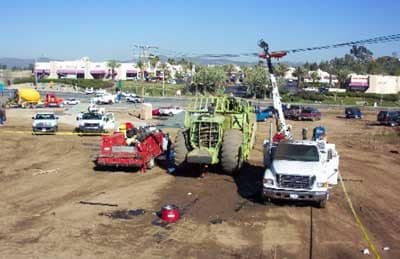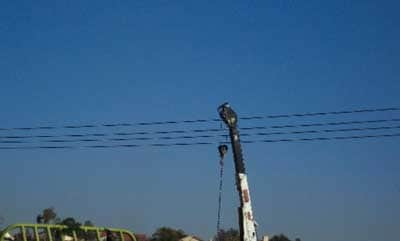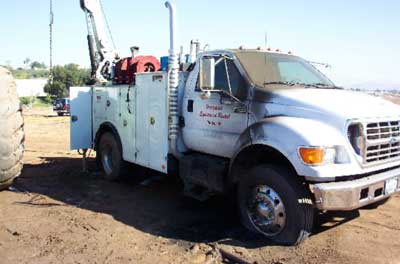Two Heavy Equipment Mechanics Electrocuted While Working on a Large Earth Moving Piece of Construction Equipment Called a Scraper
California Case Report: 04CA004
Summary
Two heavy equipment mechanics, an 18-year-old male and a 40-year-old male, died when electrocuted while working on a scraper. The scraper was at a construction site parked under a high voltage line. The victims were using the truck-mounted crane on one of their service trucks to assist in replacing the rear differential when the incident occurred. The crane’s boom made contact with the high voltage line. The control for the crane was a remote unit electrically wired to the truck. The 18-year-old victim was operating the crane at the time of the incident. The CA/FACE investigator determined that, in order to prevent future occurrences, employers, as part of their Injury and Illness Prevention Program (IIPP), should:
- Ensure heavy equipment mechanics know the safety and health hazards specific to their job assignments.
- Ensure all employees perform safety and health inspections prior to starting their job assignments in order to find, eliminate, or control safety and health hazards as well as unsafe working conditions and practices, and to comply fully with the safety and health standards.
- Ensure all employees are provided with mechanical and physical safeguards to the maximum extent possible in order to perform their job assignments safely.
- Ensure heavy equipment mechanics are properly trained on machine operation and safety and their achievement of skills is verified through a testing program.
Introduction
On February 5, 2004, at approximately 9 a.m., two heavy equipment mechanics, an 18-year-old male and the other a 40-year-old male, died when electrocuted while working on a scraper. The CA/FACE investigator learned of this incident on February 25, 2004, through the Legal Unit of the Division of Occupational Safety and Health (Cal/OSHA). On May 20, 2004, the CA/FACE investigator traveled to the business where the victims were employed, interviewed the company’s president, and gathered statistical information on the company and victims. Copies of the police report and pictures they took were also obtained.
The employer of the victims was a company that rented scrapers to construction contractors. The company had been in business for ten years and had 20 employees. There were six employees of the company at the site where the incident took place. The 18-year-old victim had been employed by the company for one year. The 40-year-old mechanic had 20 years of experience as a heavy equipment mechanic and had been employed with the company for one month.
The company did not have a written safety program. There were no written instructions on safety for the employees to follow. Safety meetings were held monthly but were not documented. The company did not have a training program. According to the company president, all their training needs were contracted out through another agency. The agency was contacted but was unable to produce any records of training received by the victims.
Investigation
The site of the incident was a 45-acre construction site being graded for commercial development. On the day of the incident the victims were dispatched to the site to perform repairs on a scraper. The scraper was parked underneath a high voltage power line that contained 12,000 volts of electricity (12 kv) and ran directly through the construction site. The victims arrived at the incident site and parked their trucks approximately four feet away on opposite sides of the scraper. The victims disconnected and removed the rear differential from the scraper using the truck-mounted crane on one of the trucks to lift it out of the scraper. The controls for the truck crane were portable and connected to the truck by an electrical cable. The 18-year-old victim was working the crane controls from inside the scraper apron, and the 40-year-old victim was on the bottom of the scraper where the dirt is first picked up. After installing the new rear differential in the scraper using the crane, the boom was being moved out of the way. It made contact with the overhead electrical line, sending electrical current down the boom, through the truck, into the boom control attached to the truck, and into the 18-year-old victim who was holding the control while inside the scraper apron. The chain attached to the hook of the crane cleared the scraper, so it was not an electrical path. The electrical current went into the scraper and into the 40-year-old victim who was also in contact with the scraper. Both victims were electrocuted and set on fire.
An equipment operator at the site, who was about 40 feet away, heard the electrical arc and saw both victims on fire. He grabbed a fire extinguisher and ran toward them in an attempt to put the fire out. As he approached the scraper, he was shocked by the ground current and lost consciousness. After several minutes, the equipment operator regained consciousness and walked away.
The police and fire departments responded within a few minutes after being called by other employees at the scene and were able to put the fires out. The electric company was called and had to de-energize the overhead lines before the paramedics could reach the victims. The paramedics pronounced both victims dead at the scene.
Cause of Death
The cause of death for each victim, according to their death certificates, was electrocution.
Recommendations/Discussion
Recommendation # 1: Ensure heavy equipment mechanics know the safety and health hazards specific to their job assignments.
Discussion: Heavy equipment mechanics that travel to different construction sites to perform repairs on equipment are often subjected to different work environments and safety hazards beyond their normal scope of work. Heavy equipment mechanics need to be aware of any potential safety hazard that might interfere with their job. In this case, the victims needed to be able to recognize the hazards associated with hoisting equipment and materials, especially near overhead power lines. One method of ensuring this is to have a “Code of Safe Practices” available for all employees which lists the potential safety hazards that could possibly be encountered in the scope of their work.
Recommendation #2: Ensure all employees perform safety and health inspections prior to starting their job assignments in order to find, eliminate, or control safety and health hazards as well as unsafe working conditions and practices, and to comply fully with the safety and health standards.
Discussion: Employers should conduct initial jobsite surveys to identify potential worker hazards. Once potential hazards have been identified, appropriate control measures can be implemented prior to the start of any work. Control measures in this incident could have included positioning the truck-mounted crane so the crane boom would not come within ten feet of the power line, or posting an observer to ensure the crane operator did not move the boom within ten feet of the power line. Other control measures could have included contacting the power company and having them de-energize the power line, or insulating (“sleeving”) the power line phases with line hoses, or moving the scraper from underneath the power line.
Recommendation #3: Ensure all employees are provided with mechanical and physical safeguards to the maximum extent possible in order to perform their job assignments safely.
Discussion: The remote control system used on the truck-mounted crane was electrically connected to the crane. This system provided the “path to ground” which resulted in two fatalities. A remote control system which is electrically isolated from the crane would provide protection to a crane operator if contact with an energized overhead power line occurred. Electrical isolation could be accomplished by radio controls, fuse equipped control lines, fiber optic controls, insulated control boxes, etc. Manufacturers of crane systems should evaluate these options and incorporate an electrically isolated remote control system into the design of newly manufactured truck-mounted cranes. Manufacturers and their customers should cooperate in an effort to retrofit existing truck-mounted cranes with these systems, as well.
Recommendation #4: Ensure heavy equipment mechanics are properly trained on machine operation and safety and their achievement of skills is verified through a testing program.
Discussion: All workers who are required to operate truck-mounted cranes should be provided with appropriate training. At minimum, such training should address OSHA standards applicable to cranes, the hazards associated with hoisting equipment and materials, especially near overhead power lines and the positioning of truck-mounted cranes to maintain a ten foot minimum clearance from overhead power lines, and the use of established procedures in emergency situations. Safe work practices can be enhanced through programs of task-specific training, supervision, rewards, and progressive disciplinary measures.
Exhibits
 |
 |
 |
|
Exhibit #3. The victims’ truck with the boom that made contact with the high voltage lines.
|
Reference
- California Code of Regulations, Vol. 9, Title 8, Sections 1509, 1938, 2946, 4552
FACE 90-39, 89-48
California Fatality Assessment and Control Evaluation (FACE) Project
The California Department of Health Services, in cooperation with the Public Health Institute and the National Institute for Occupational Safety and Health (NIOSH), conducts investigations on work-related fatalities. The goal of this program, known as the California Fatality Assessment and Control Evaluation (CA/FACE), is to prevent fatal work injuries in the future. CA/FACE aims to achieve this goal by studying the work environment, the worker, the task the worker was performing, the tools the worker was using, the energy exchange resulting in fatal injury, and the role of management in controlling how these factors interact. NIOSH funded, state-based FACE programs include: Alaska, California, Iowa, Kentucky, Massachusetts, Michigan, Minnesota, Nebraska, New Jersey, New York, Oklahoma, Oregon, Washington, West Virginia, and Wisconsin.
To contact California State FACE program personnel regarding State-based FACE reports, please use information listed on the Contact Sheet on the NIOSH FACE website. Please contact In-house FACE program personnel regarding In-house FACE reports and to gain assistance when State-FACE program personnel cannot be reached.
